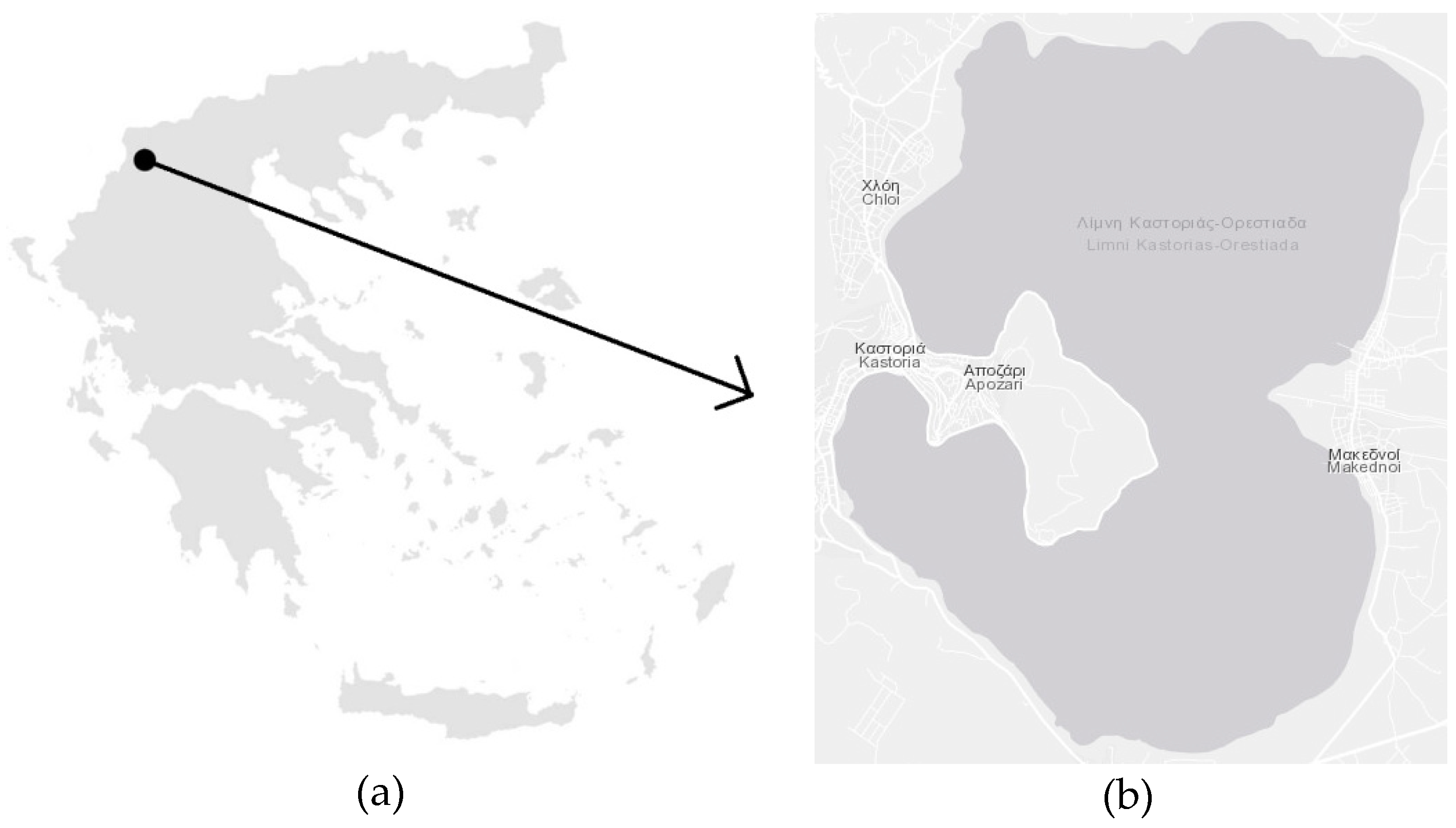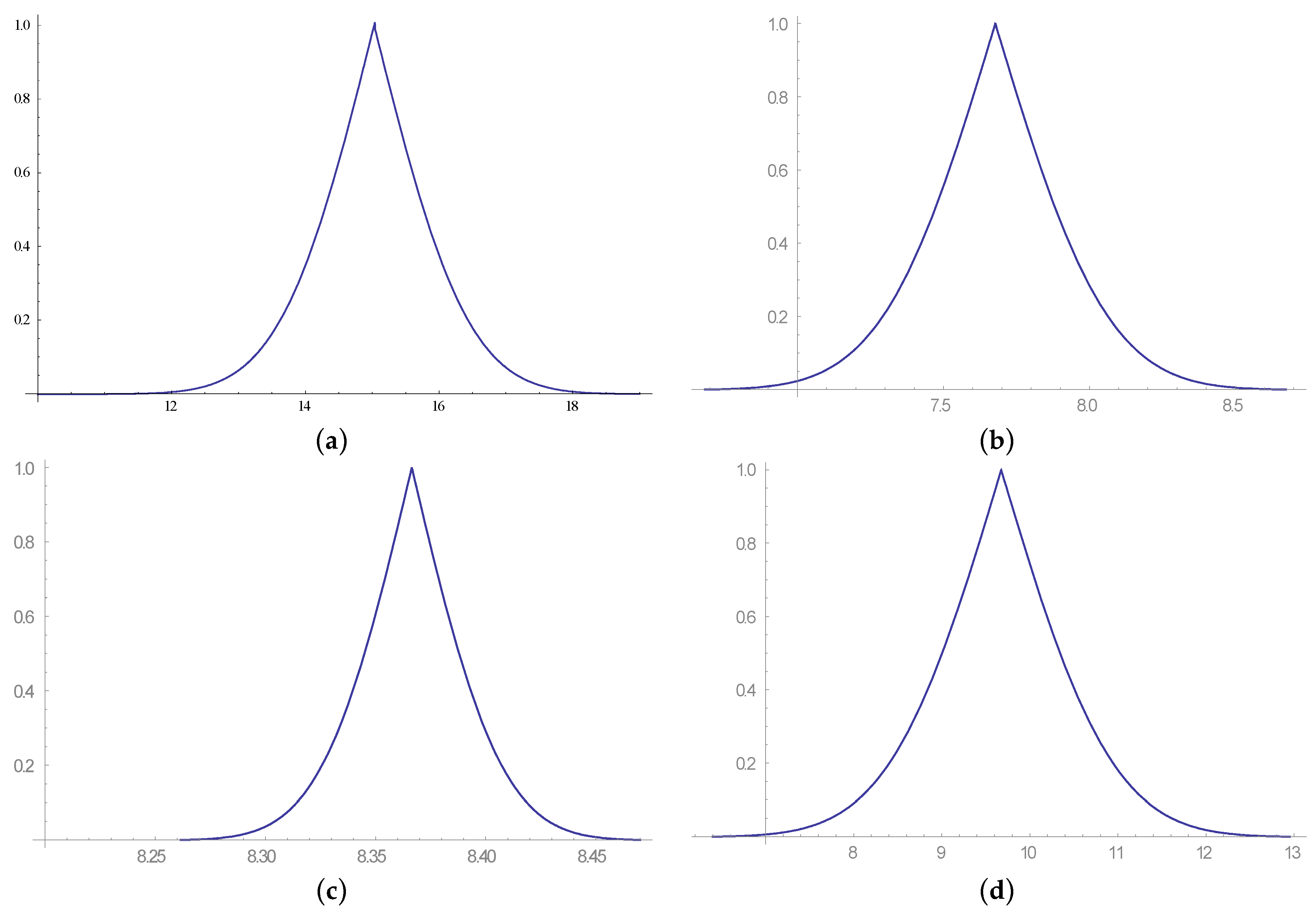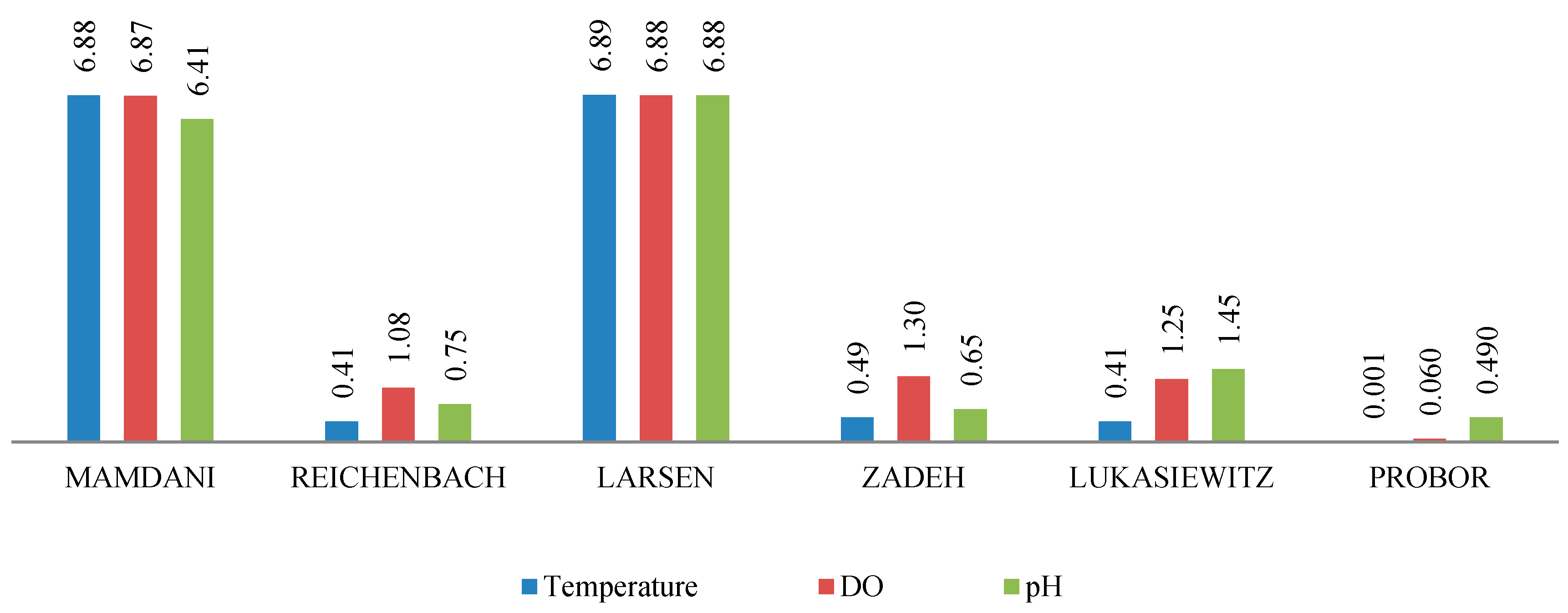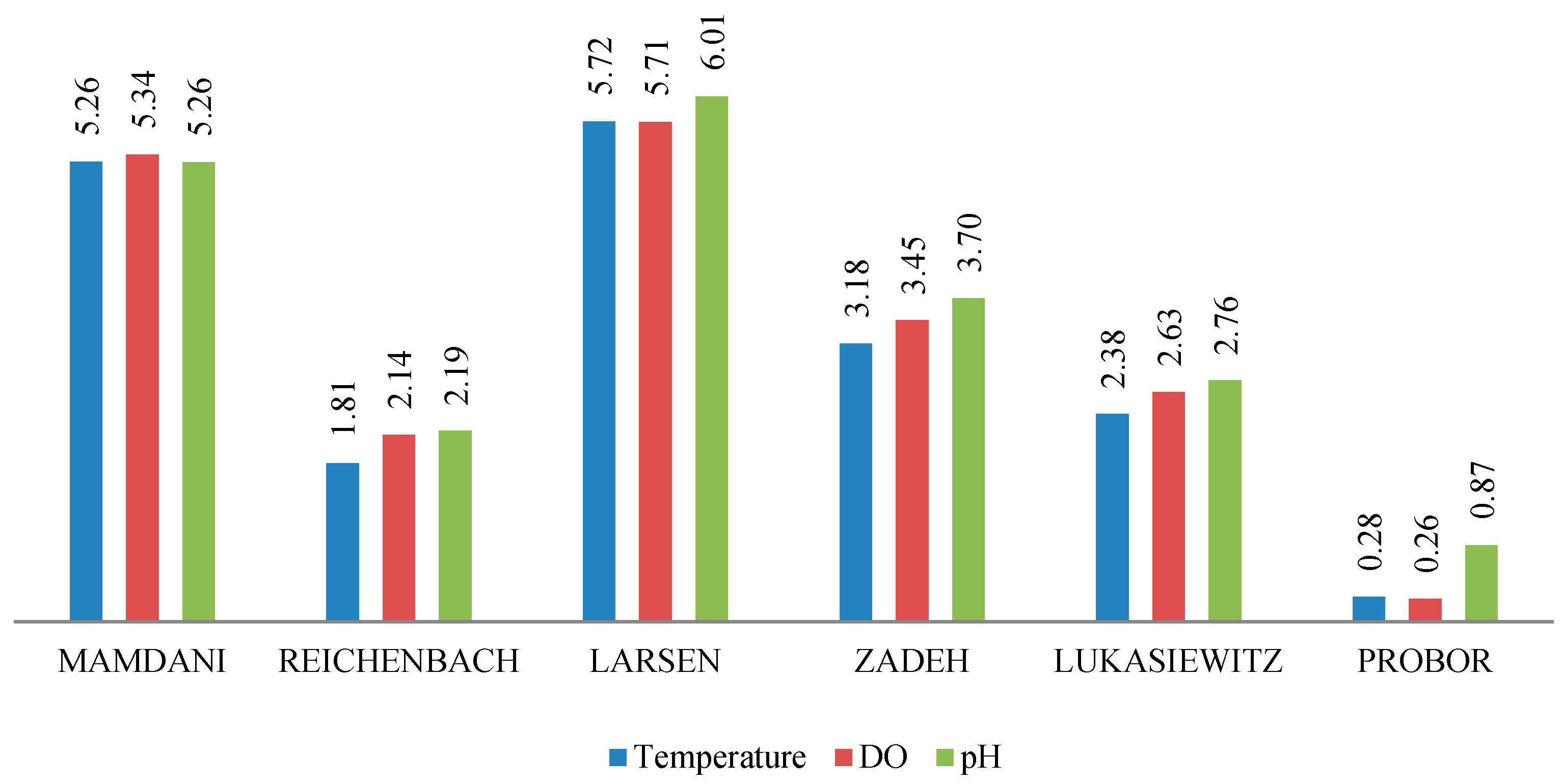The Use of Fuzzy Estimators for the Construction of a Prediction Model Concerning an Environmental Ecosystem
Abstract
1. Introduction
2. Materials and Methods
2.1. Study Area
2.2. Database and Model Application in Lake Kastoria
- Water temperature: Temperature is directly related to the solubility of oxygen, the metabolism of aquatic organisms, and the process of decomposition of the organic substances it contains. The rise in temperature results in a reduction in dissolved oxygen, necessary for the survival of the aquatic organisms, and reduces the water density. The lightest water rises to the surface and stays there, creating a warmer layer with lower atmospheric oxygen dissolution capacity [16]. This may be fatal for organisms housed or preserved in water (e.g., plankton, fish, shells, amphibians, etc.). In addition, high temperatures promote the proliferation and growth of bacteria and other microorganisms.
- pH: Natural waters have pH values ranging between 4 and 9. Legislation sets the permitted limits for pH in the 6.5–8.5 range for drinking water. Natural fresh water has a slightly alkaline pH because of the presence of carbonate and bicarbonate ions. Because of agriculture drainage, pH affects the nitrogen and phosphorus release of the deposit sediment [17] and influences the eutrophication phenomenon in water bodies like rivers and lakes. This parameter has a great importance for water environments [18].
- DO: Dissolved oxygen plays a key role in aquatic ecosystems. Most life forms need oxygen to survive. The water receiver has the ability to maintain a maximum dissolved oxygen concentration, called the saturation concentration. Decreasing the concentration of dissolved oxygen to levels below the saturation value leads to degradation of the organic matter, while the aquatic lives are significantly affected or even killed.
- Chlorophyll: The knowledge of the chlorophyll concentration in an ecosystem provides useful information for assessing the phytoplankton biomass in a water area, and is an indicator of pollution from eutrophication [11].
2.3. Description of the Fuzzy Estimators and Fuzzy Implications
3. Results
- the true values of the corresponding implications
- p = 1, 2, and 3: the examined independent parameters (water temperature, DO, pH);
- i = 1, 2, 3, 4, 5, and 6: the implications (Mamdani, Larsen, Zadeh, Lukasiewicz, Reichenbach, Probor);
- the number of true values.
4. Discussion
5. Conclusions
Author Contributions
Funding
Acknowledgments
Conflicts of Interest
Appendix A

References
- Stefanidis, K.; Dimitriou, E. Differentiation in Aquatic Metabolism between Littoral Habitats with Floating-Leaved and Submerged Macrophyte Growth Forms in a Shallow Eutrophic Lake. Water 2019, 11, 287. [Google Scholar] [CrossRef]
- Demertzi, K.; Papadimos, D.; Aschonitis, V.; Papamichail, D. A Simplistic Approach for Assessing Hydroclimatic Vulnerability of Lakes and Reservoirs with Regulated Superficial Outflow. Hydrology 2019, 6, 61. [Google Scholar] [CrossRef]
- Xu, C.; Wang, H.U.; Yu, Q.; Wang, H.Z.; Liang, X.M.; Liu, M.; Jeppesen, E. Effects of Artificial LED Light on the Growth of Three Submerged Macrophyte Species during the Low-Growth Winter Season: Implications for Macrophyte Restoration in Small Eutrophic Lakes. Water 2019, 11, 1512. [Google Scholar] [CrossRef]
- Zheng, T.; Cao, H.; Liu, W.; Xu, J.; Yan, Y.; Lin, X.; Huang, J. Characteristics of Atmospheric Deposition during the Period of Algal Bloom Formation in Urban Water Bodies. Sustainability 2019, 11, 1703. [Google Scholar] [CrossRef]
- Doulgeris, C.; Papadimos, D.; Kapsomenakis, J. Impacts of climate change on the hydrology of two Natura 2000 sites in Northern Greece. Reg. Environ. Chang. 2016, 16, 1941–1950. [Google Scholar] [CrossRef]
- Wang, W.; Lee, X.; Xiao, W.; Liu, S.; Schultz, N.; Wang, Y.; Zhang, M.; Zhao, L. Global lake evaporation accelerated by changes in surface energy allocation in a warmer climate. Nat. Geosci. 2018, 11, 410–414. [Google Scholar] [CrossRef]
- IPCC. Summary for policymakers. In Climate Chang. 2013: The Physical Science Basis. Contribution of Working Group I to the Fifth Assessment Report of the Intergovernmental Panel on Climate Change; Stocker, T.F., Qin, D., Plattner, G.K., Tignor, M., Allen, S.K., Boschung, J., Nauels, A., Xia, Y., Bex, V., Midgley, P.M., Eds.; Cambridge University Press: Cambridge, UK; New York, NY, USA, 2013. [Google Scholar]
- Leon-Munoz, J.; Echeverria, C.; Marce, R.; Riss, W.; Sherman, B.; Iriarte, J.L. The combined impact of land use change and aquaculture on sediment and water environmental quality in oligotrophic Lake Rupanco. J. Environ. Manag. 2013, 128, 283–291. [Google Scholar] [CrossRef]
- Lin, B.; Chen, X.; Yao, H.; Chen, Y.; Liu, M.; Gao, L.; James, A. Analyses of land use change impacts on catchment runoff using different time indicators based on SWAT model. Ecol. Indic. 2015, 58, 55–63. [Google Scholar] [CrossRef]
- Matzafleri, N.; Psilovikos, A.; Neofytou, C.; Kagalou, I. Determination of the Trophic Status of Lake Kastoria, Western Macedonia, Greece. In Proceedings of the Small and decentralised water and wastewater treatment plants IV, Volos, Greece, 25–27 October 2013; ISBN 978-960-6865-72-5. [Google Scholar]
- Richardson, K.; Jørgensen, B.B. Eutrophication in a Coastal Marine Ecosystem; Coastal and estuarine studies; American Geophysical Union: Washington, DC, USA, 1996; Volume 1, pp. 1–9. [Google Scholar]
- Ellina, G.; Papaschinopoulos, G.; Papadopoulos, B.K. Fuzzy inference systems: Selection of the most appropriate fuzzy implication in terms of statistical data. Environ. Process. 2017, 4, 923–935. [Google Scholar] [CrossRef]
- Botzoris, G.; Papadopoulos, K.; Papadopoulos, B.K. A method for the evaluation and selection of an appropriate fuzzy implication by using statistical data. Fuzzy Econ. Rev. 2015, XX, 19–29. [Google Scholar] [CrossRef]
- Ellina, G.; Papaschinopoulos, G.; Papadopoulos, B.K. Research of Fuzzy Implications via Fuzzy Linear Regression in Data Analysis for a Fuzzy Model. J. Comput. Methods Sci. Eng. 2019. accepted for publication. [Google Scholar]
- Moustaka-Gouni, M.; Vardaka, E.; Michaloudi, E.; Kormas, K.A.; Tryfon, E.; Mihalatou, H.; Gkelis, S.; Lanaras, T. Plankton food web structure in a eutrophic polymictic lake with a history in toxic cyanobacterial blooms. Limnol. Oceanogr. 2006, 51, 715–727. [Google Scholar] [CrossRef]
- Ellina, G.; Kagalou, I. Selection of the most appropriate parameter for the chlorophyll-a estimation of an artificial lake via fuzzy linear regression. Eur. Water 2016, 55, 105–114. [Google Scholar]
- Tao, Y.; Wang, S.; Guan, X.; Xu, D.; Chen, H.; Ji, M. Study on Characteristics of Nitrogen and Phosphorus Loss under an Improved Subsurface Drainage. Water 2019, 11, 1467. [Google Scholar] [CrossRef]
- Fisher, L.H. Effect of Water-Column pH on Sediment-Phosphorus Release Rates in Upper Klamath Lake, Oregon, 2001; U.S. Geological Survey: Reston, VA, USA, 2004. [Google Scholar]
- Profillidis, V.A.; Papadopoulos, B.K.; Botzoris, G.N. Similarities in fuzzy regression models and application on transportation. Fuzzy Econ. Rev. 1999, 4, 83–98. [Google Scholar] [CrossRef]
- Papadopoulos, B.; Tsagarakis, K.P.; Yannopoulos, A. Cost and land functions for wastewater treatment projects: Typical simple linear regression versus fuzzy linear regression. J. Environ. Eng. 2007, 133, 581–586. [Google Scholar] [CrossRef]
- Sfiris, D.S.; Papadopoulos, B.K. Non-asymptotic fuzzy estimators based on confidence intervals. Inf. Sci. 2014, 279, 446–459. [Google Scholar] [CrossRef]
- Ellina, G.; Papaschinopoulos, G.; Papadopoulos, B.K. Research of Fuzzy Implications via Fuzzy Linear Regression in a Eutrophic Waterbody. In AIP Conference Proceedings 1978; AIP Publishing: New York, NY, USA, 2018; p. 290007. [Google Scholar] [CrossRef]
- Papadopoulos, B.K.; Sirpi, M.A. Similarities in fuzzy regression models. J. Optim. Theory Appl. 1999, 102, 373–383. [Google Scholar] [CrossRef]
- Chrysafis, K.A.; Papadopoulos, B.K. Cost–volume–profit analysis under uncertainty: A model with fuzzy estimators based on confidence intervals. Int. J. Prod. Res. 2008, 47, 5977–5999. [Google Scholar] [CrossRef][Green Version]
- Brito, D.; Neves, R.; Branco, M.A.; Prazeres, A.; Rodrigues, S.; Maria, C.; Gonçalves, M.C.; Ramos, T.B. Assessing Water and Nutrient Long-Term Dynamics and Loads in the Enxoé Temporary River Basin (Southeast Portugal). Water 2019, 11, 354. [Google Scholar] [CrossRef]
- Buriboev, A.; Kang, H.K.; Ko, M.C.; Oh, R.; Abduvaitov, A.; Jeon, H.S. Application of Fuzzy Logic for Problems of Evaluating States of a Computing System. Appl. Sci. 2019, 9, 3021. [Google Scholar] [CrossRef]
- Pagouropoulos, P.; Tzimopoulos, C.; Papadopoulos, B. Selecting the most appropriate fuzzy implication based on statistical data. Int. J. Fuzzy Syst. Adv. Appl. 2016, 3, 32–42. [Google Scholar]
- Pagouropoulos, P.; Tzimopoulos, C.; Papadopoulos, B. A Method for the Detection of the Most Suitable Fuzzy Implication for Data Applications. In Engineering Applications of Neural Networks, Communications in Computer and Information Science; Springer: Heidelberg, Germany, 2017; Volume 744, pp. 242–255. [Google Scholar]




© 2019 by the authors. Licensee MDPI, Basel, Switzerland. This article is an open access article distributed under the terms and conditions of the Creative Commons Attribution (CC BY) license (http://creativecommons.org/licenses/by/4.0/).
Share and Cite
Ellina, G.; Papaschinopoulos, G.; Papadopoulos, B. The Use of Fuzzy Estimators for the Construction of a Prediction Model Concerning an Environmental Ecosystem. Sustainability 2019, 11, 5039. https://doi.org/10.3390/su11185039
Ellina G, Papaschinopoulos G, Papadopoulos B. The Use of Fuzzy Estimators for the Construction of a Prediction Model Concerning an Environmental Ecosystem. Sustainability. 2019; 11(18):5039. https://doi.org/10.3390/su11185039
Chicago/Turabian StyleEllina, Georgia, Garyfalos Papaschinopoulos, and Basil Papadopoulos. 2019. "The Use of Fuzzy Estimators for the Construction of a Prediction Model Concerning an Environmental Ecosystem" Sustainability 11, no. 18: 5039. https://doi.org/10.3390/su11185039
APA StyleEllina, G., Papaschinopoulos, G., & Papadopoulos, B. (2019). The Use of Fuzzy Estimators for the Construction of a Prediction Model Concerning an Environmental Ecosystem. Sustainability, 11(18), 5039. https://doi.org/10.3390/su11185039





